Summary This report describes the activities of the Meru mobile veterinary unit (Meru MVU) during the month of March 2013
Summary
This report describes the activities of the Meru mobile veterinary unit (Meru MVU) during the month of March 2013. This month marked the onset of the rainy season in Meru and Laikipia areas which is expected to continue into the month of April. Five incidences of injuries to wildlife were reported, four out five involved elephants. These incidences occurred in Naibunga and Mpala ranches in Laikipia, Meru national park and Mwea national reserve.
Lameness in elephant in Meru national park
The warden in charge of the rhino sanctuary in Meru national park reported an elephant showing lameness within the sanctuary on 8th March 2013. This animal was promptly attended to by the Meru MVU.
Chemical immobilization
Darting was conducted on foot after tracking the elephant with the help of rhino monitoring rangers. This was an old bull more than 35 years old. Etorphine Hcl 18mg in a single 3 cc DanInject dart with 2.2 60 mm needle was used. The dart was placed in the gluteal muscles on the right side of the body. Locating the immobilized animal took 40 minutes because of the challenge caused by dense bush. On contact its eyes were covered using ear flaps to prevent visual stimulation and elephant doused with copious amount of water to keep it cool. After the procedure, to reverse the animal from anaesthesia 12mg/ml Diprenophine Hcl 60mg was injected intravenously into superficial ear veins.
Examination and treatment
Examination revealed a swollen left forelimb distal to the carpal joint which was also circumscribed by scar tissue. Probing using a needle did not show a snare wire which may have fallen off. Diagnosis: Healing snare wire injury. This case has a good prognosis due to absence of infection and signs of healing. Treatment: Thorough wash with water and application of iodine Prophylactic antibiotic administration. Amoxicillin trihydrate 30g given intramuscularly 0.1% Dexamethasone sodium 5omg intramuscularly
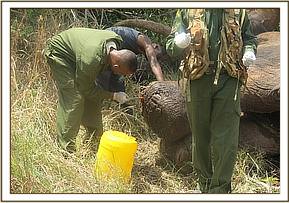
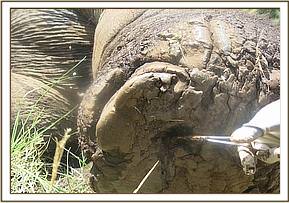
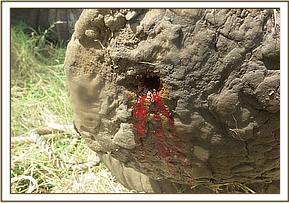
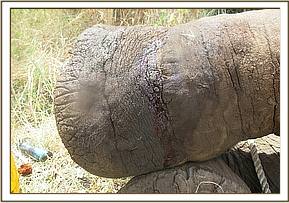
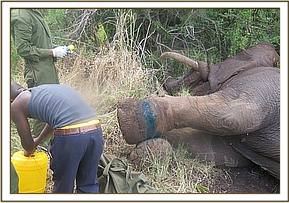

Injured elephant in Naibunga community conservancy, Laikipia
On 20th March 2013 Meru MVU received report from the management of Naibunga conservancy of an elephant that required veterinary attention. This was an adult bull that had been monitored by community rangers for 3 days hence was easily located on arrival. Standard elephant immobilization procedure was followed. The elephant was darted from a vehicle after a brief chase. Induction time was seven minutes. Examination revealed superficial wounds and bruises on the right flank. Treatment: Wash with antiseptic and iodine applied. Elephant was successfully reversed from anaesthesia.
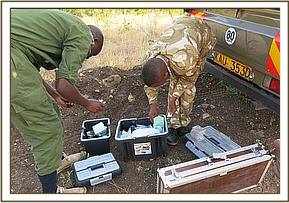
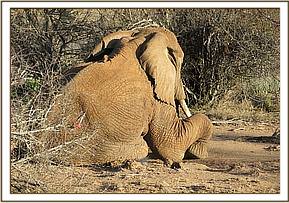
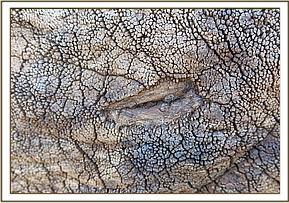


Other reported cases
i. The warden Mwea national reserve requested the Meru MVU on 13th March 2013 to attend to an elephant and two common zebras with wire snares. The elephant was reported to have a penetrating wound on its trunk hence difficulty during watering. The wound was suspected to have been caused by a snare. After 2 days of searching for the elephant, we were unable to locate it. The reserve management was advised to follow up on this animal and report for prompt treatment when it is found. Two zebras with snares on their limbs were located; however, attempts to dart were not successful. The zebras were agitated and fled when approached by vehicle. Because of rough terrain it was not possible to pursue these animals.
ii. Mpala ranch in Laikipia requested for veterinary support to assess a sick elephant. Meru MVU visited the ranch on 25th March 2013. The male elephant was located in a water hole. Quick assessment revealed an old elephant bull in poor body condition. No injury was seen externally. This animal was not immobilized. The ranch was advised to monitor the animal.
Conclusion
There were few incidences of injuries to wildlife in March, however, all cases reported were attended to promptly.
Acknowledgements
We would like to thank the David Sheldrick Wildlife Trust for funding the operations of the Meru MVU.
Report by: Dr Bernard Rono